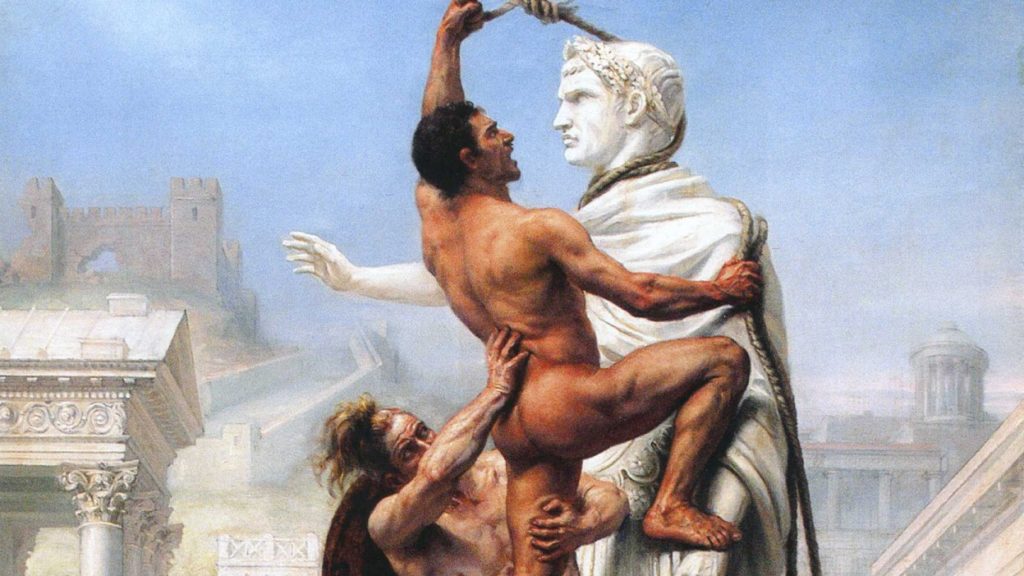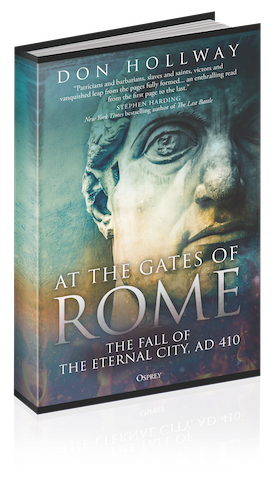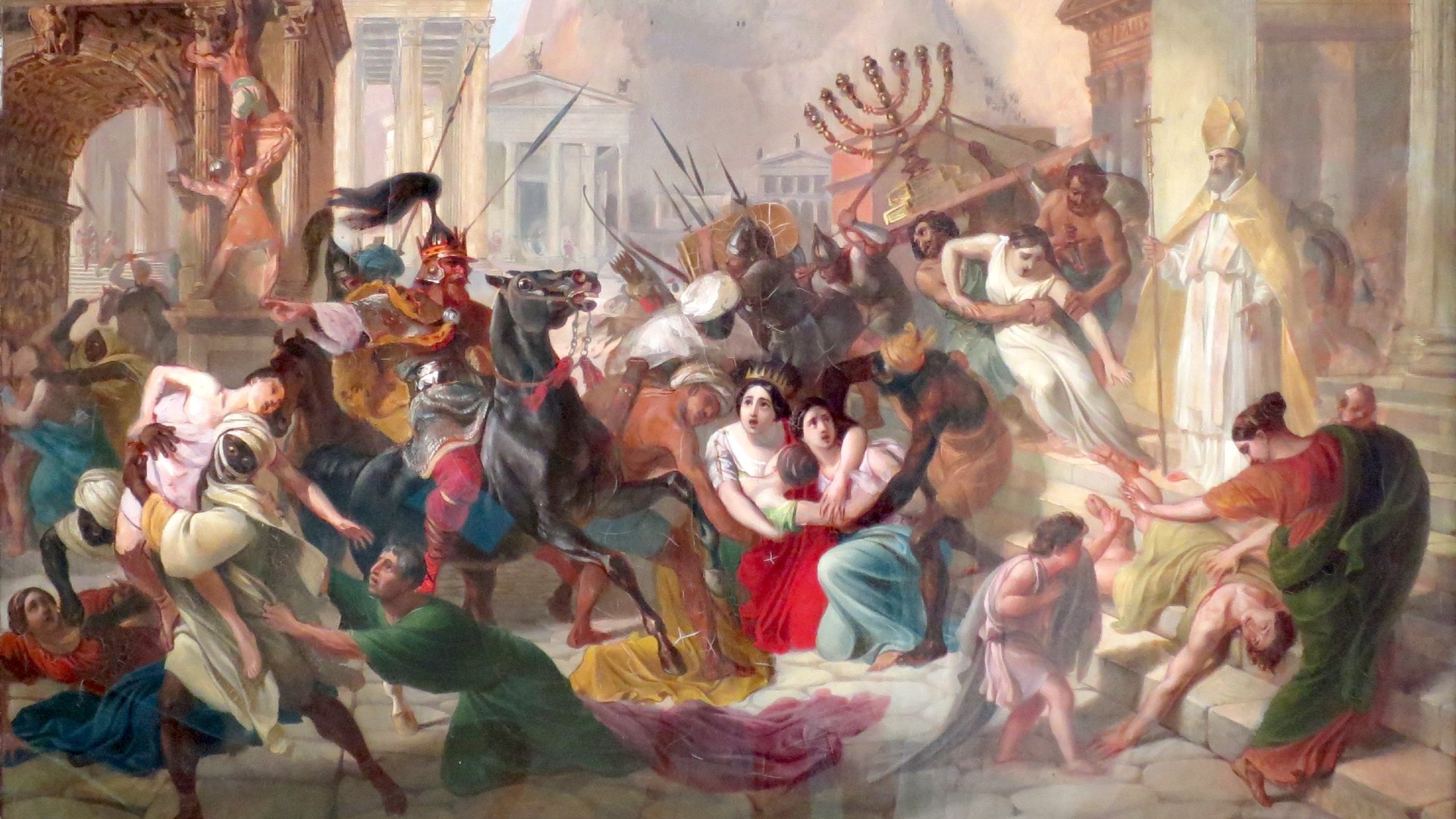The real history of how and why Rome collapsed is more complicated than you may know as we learn from historian Don Hollway
Banner Image Source: Wiki/Karl Bryullov
In At the Gates of Rome, from Osprey Publishing, Don Hollway unpacks the story of the sacking of Rome in 410 CE through the stories of two prominent leaders, one a Roman general, the other a king of the Goths. Through meticulous research and storytelling, Hollway recounts the campaigns, plots and power struggles behind Rome’s final years.

For more from Don visit www.donhollway.com or follow him on Twitter @HollwayDon
At what point in the history of the Roman Empire does At the Gates of Rome pick up? How long had Rome been in decline at this point?
You could argue that it had been declining ever since the ‘Crisis of the Third Century’ – decades of civil strife, economic upheavals, plague, invasions and warfare. By the mid-4th century the empire was divided in two halves, East and West. They did not always get along.
But At the Gates of Rome really begins with the Battle of Adrianople in 378 CE. The Goths, trying to escape the pressure of the Huns on the eastern steppes, were eager to become assimilated – subjects of the empire – in exchange for its protection. This longstanding policy had greatly benefitted both the empire and barbarian immigrants. “This, more than anything else, is why Rome flourished,” declared the 1st century historian Plutarch. “She always united and assimilated within herself those whom she conquered.”
However, instead of assimilating the Goths, corrupt authorities mistreated and abused them to the point that they went on a rampage. At Adrianople, Eastern Emperor Flavius Valens brought an imperial army to stop them but the Romans were annihilated, Valens was killed and the Goths came into the empire unconquered, on their own terms. For them it amounted to a successful invasion.
At the Gates of Rome recounts the fall of Rome in 410 through two prominent figures, General Flavius Stilicho and Alaric, King of the Goths. What are the main sources we have regarding these two men? Did you have to make any historical interpretation in order to tell the story more completely?
Stilicho is better documented than Alaric. The Egyptian-born court poet Claudius Claudianus, remembered as Claudian, was his veritable press secretary and propagandist. He was a valuable eyewitness, but always spun events to Stilicho’s advantage. Luckily, there were plenty of writers even at the time who were no fans of Stilicho. The historians and theologians Jerome of Stridon and Paulus Orosius both blamed him for the fall of Rome, even though by that time Stilicho was dead. They, and other more neutral accounts of events, balance Claudian’s view.
Alaric had no publicist. We know him by his exploits. As the man who sacked Rome, he was a popular topic back in the day. Few writers knew him personally, but Stilicho did, and we can view Alaric through him.
An historian has an advantage in knowing how a story ends. With that foresight you can see why historical characters did what they did. I like to quote the primary sources, letting the people who were there speak for themselves. When I fill in some blanks – speculate, or interpret events as I see them – I make it clear to my readers.

What caused the Goths and Romans to become allies and why did this alliance break down?
The new emperor, Theodosius, needed to replenish his army and control the Goths. He did both by giving them amnesty and recruiting their warriors into the legions. Then, at the Battle of the Frigidus River in 394 CE, he sent them into battle first, poorly supported.
They suffered 50 percent casualties, with 10,000 killed. Even contemporary writers suspected that he purposely thinned their ranks. Afterward, Stilicho used the Goths to make trouble for the Eastern empire, but Alaric no longer trusted the Romans. He played the two empires against each other, making his people the deciding factor in the balance of power.
A common view of the fall of Rome is that it was a conflict between civilised Romans against a horde of ‘barbarians’. How accurate is this? What was the makeup of the Roman population and military during the decline of the empire?
By the early 400s CE who was Roman and who was barbarian was a grey area. Stilicho himself was half-barbarian. Most Romans had little desire to serve in the military, so the legions were almost entirely manned by barbarian mercenaries, many of them Goths. Roman bigotry led to the downfall. In 408 CE, many of the Goths’ women and children in the cities were massacred in a genocide. Thirty thousand legionaries mutinied and joined Alaric; they’re the ones who conquered Rome.
How did the Goths succeed in taking Rome in 410 CE? What were the key factors in their victory?
Goths didn’t take cities by storm – they basically just blockaded Rome and strangled it. Starving citizens resorted to cannibalism. Finally somebody – either a sympathiser, infiltrator or some poor soul just hoping for mercy – opened a gate and let the Goths in.
What do contemporary accounts tell us about the sacking of the city and the treatment of its inhabitants?
Those who lived through it, whether conquerors or conquered, left few accounts. Many would have been illiterate, their stories were lost or, of course, they never lived to tell the tale. Yet enough is known, and enough archaeological evidence has been uncovered, to piece it together. We know where the Goths entered the city and we know their progress by the destruction they left behind. Large parts of Rome were burned. Murder and rape were endemic. Christianity itself, still a new religion, was changed by the catastrophe, with church fathers going to great lengths and some convoluted reasoning to see to it that God did not get the blame.
Some of your readers might be wondering if Western Civilisation is heading down the same road as Rome, towards a fall. What do you think?

Historians have tallied over 200 reasons why the Western Empire fell – everything from its slave economy and constant civil wars to epidemic plagues, general corruption and immorality, right down to lead in the pipes. The direct cause is, of course, obvious: the invasion of the city by a barbarian horde. At the Gates of Rome shows how and why the Goths succeeded when the barbarians who came before them failed. I examined the evidence and came to my own conclusion. Given current events, some people might disagree. My readers can decide for themselves.
At the Gates of Rome is available now from Osprey Publishing
Originally published in History Of War 107
